Horizon Hobby E-flite Valiant 1.3m BNF Basic
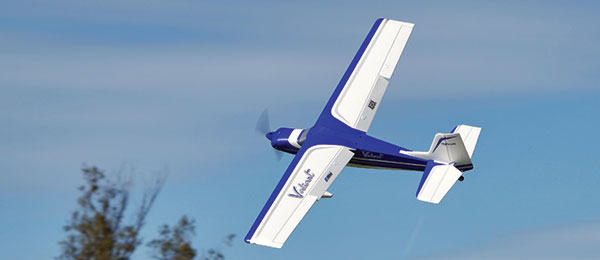
Written by Jon Barnes A sport flier’s delight Product review As seen in the August 2017 issue of Model Aviation.
Bonus video
Specifications
Model type: Sport model Skill level: Beginner to intermediate Wingspan: 53 inches Wing area: 430 square inches Length: 38 inches Weight: 40 ounces Power system: Brushless electric Radio system: Five-channel minimum required Construction: Z-Foam Street price: $199.99Test-Model Details
Motor used: E-flite 480-size 960 Kv brushless outrunner (included) Speed controller: E-flite 30-amp pro switch mode with 3.5-amp BEC; EC3 connector (included) Servos: Six E-flite/ParkZone SV80 sub-micro servos (included) Battery: E-flite 3S 11.1-volt 30C 2,200 mAh LiPo Propeller: Two-blade 11.75 x 8 Radio system: Spektrum DX9 DSMX transmitter; Spektrum AR636A AS3X/SAFE receiver (receiver included) Ready-to-fly weight: 40 ounces Flight duration: 5 to 7 minutesPluses
• Includes flaps. • Optional SAFE mode can be enabled when binding. • Can be flown on three-cell 1,300 mAh to 3,000 mAh LiPo batteries. • Mounting hardware for optional floats is included with the kit.Minus
• The lack of a water rudder can make taxiing on floats slightly challenging in windy conditions.Product review
The new Z-Foam composition E-flite Valiant ultimately traces its heritage to the substantially larger, traditional balsa and plywood Hangar 9 30cc Valiant ARF (reviewed in the April 2015 issue of Model Aviation). Pilots of the former aircraft, a giant scale 108-inch wingspan model, can go with gas or electric when selecting their power system of choice. The conveniently sized, smaller 1.3-meter wingspan version of the Valiant comes with a potent brushless electric power system already installed. Both airframes bearing the Valiant moniker feature design aesthetics that offer pilots a fresh and modern take based on classic general aviation aircraft. The BNF Basic version of the Valiant comes equipped with an AS3X and SAFE Select technology-equipped Spektrum AR636A six-channel receiver.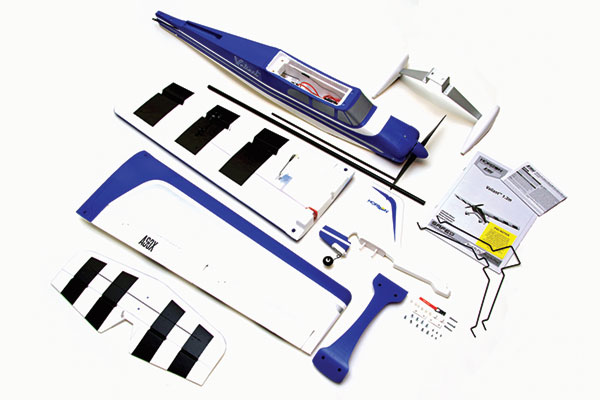
This BNF kit includes a SAFE-equipped Spektrum receiver, an abundantly powerful 480-size brushless motor and ESC, functional flaps, and all of the hardware required to mount the optional set of floats.
An optional HobbyZone float set can be purchased for roughly $25. This allows pilots to easily move the party to a pond without breaking the bank! These foam floats arrive adorned with subtle black and white generic graphics that affably align with the Valiant’s blue, black, and white scheme. All of the required float-mounting hardware is included in the box with the Valiant. Pilots will need to use some of the hardware, as well as the two float spreader bars that come packaged with the floats. After the floats have been initially assembled, they can be switched out with the Valiant’s aluminum landing gear in just a few minutes. One item that is conspicuously lacking in connection with flying the Valiant off water, however, is a water rudder (more on that detail in the flying section).
Assembly
The assembly manual touts that Valiant pilots have the option of configuring the SAFE mode that is integrated into the included Spektrum AR636A receiver so that it can be invoked at will and as needed. While binding the model to their transmitter, pilots must decide whether they want the benefits of SAFE mode at their beck and call during flight. If pilots follow the binding procedure that enables SAFE mode, it can subsequently be assigned to a switch of the pilot’s choice. Programming details provided in the assembly manual that are worth paying close attention to include the manufacturer’s recommendation to use differential on the ailerons. Doing so is sure to help keep the aileron rolls of this high-wing aircraft on the axial side. A handful of fasteners are all that stand between the Valiant being transformed from a half-dozen airframe components into a completed and flight-ready airplane. Pilots who plan to subject their Valiant to more extreme flight maneuvers might want to secure the forward part of the vertical stabilizer to the fuselage with some double-sided adhesive tape. The fasteners used to secure it and the horizontal stabilizer to the fuselage are positioned toward the rear of the empennage and consequently allow the most forward part of the fin to move slightly in relationship to the fuselage.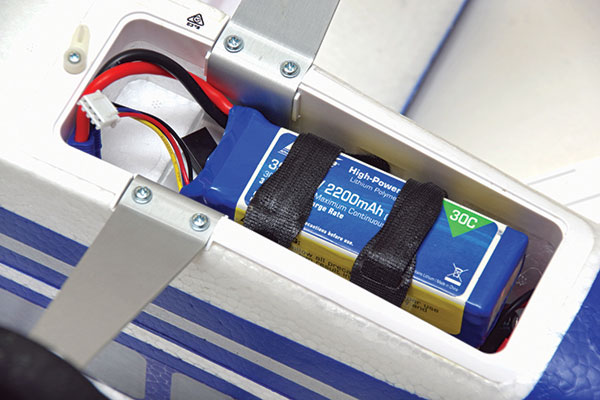
Although E-flite recommends a three-cell 2,200 mAh LiPo battery, pilots who place a premium on longer flight durations will find that the battery bay will accommodate a larger 3,000 mAh pack.
The included main landing gear is a notably stout piece of aluminum stock. Instead of merely surface mounting it to the underside of the fuselage, as is often the case with the fixed gear used on many ARF models, its more complex profile keys securely up, into, and through the battery bay. This results in it becoming a more integral part of the airframe and sets the stage for it to be able to more capably endure the rough and tumble abuse typically doled out to the landing gear by less-experienced pilots. The Valiant’s high-wing configuration means that the battery bay is located on the underside of the fuselage. Access is gained by rotating the plastic lock out of the way and removing the hard plastic bay door. The plastic battery tray features a pair of hook-and-loop retention straps and is big enough to accommodate larger capacity three-cell battery packs than the 2,200 mAh capacity packs favored by many pilots. A three-cell 3,000 mAh pack is not only condoned by the manufacturer, but fits in the provided space with little complaint and is sure to offer extended flight durations to pilots who place a premium on them.
Flying
The Valiant’s 53-inch wingspan is relatively long and subtly tapered, resulting in a surprisingly large amount of wing area. With a 3S 2,200 mAh battery loaded into the model, the wing cube loading calculates out to a trainerlike 13.4 ounces per square foot. Although the sheer length of the wing creates the illusion of a short-coupled airframe, the Valiant exhibits no pitch sensitivity whatsoever when flown at the recommended center of gravity (CG). This model’s lightly loaded airframe becomes apparent early in the takeoff roll. With surprisingly little forward velocity achieved, the Valiant is quick to lift its tail and pivot up and onto the main gear. Having the rudder active and effective so early in the takeoff roll makes it much easier for pilots with a less-refined tail-dragger skillset to hold the model on the centerline during both departures and arrivals. Though not billed as a Short Takeoff & Landing (STOL) specialist, the Valiant wastes no time in becoming airborne. This is especially true when flying with full flaps deployed and in a moderate headwind. Even with the added weight and bulk of the floats hanging below the airframe, the Valiant can impressively execute extremely short takeoffs and landings!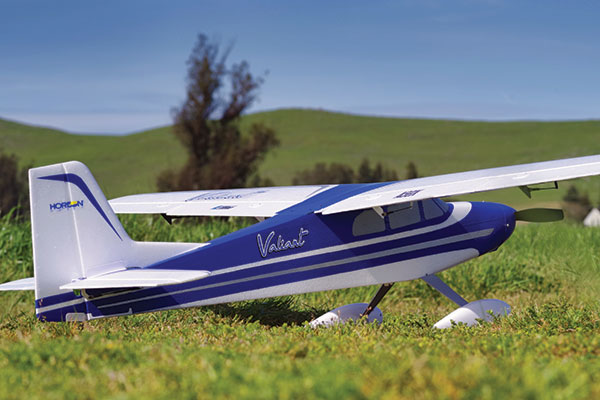
The Valiant features recognizable classic general aviation styling, an abundance of wing area, and an orientation-enhancing blue, white, and black color scheme.
The Valiant’s in-flight performance is sure to satisfy pilots who enjoy electric-powered sport models. The included brushless power system, which generates 275 to 300 watts of power at wide-open throttle, capably pulls the Valiant through nearly any basic aerobatic maneuver a pilot cares to perform. Pilots will rejoice to find that in-flight orientation is practically bulletproof thanks to the large black stripes covering the bottom of the wing and the horizontal stabilizer. Although vertical uplines are not by any means unlimited duration, the Valiant can indeed climb with gusto! With the throttle relaxed to more modest power levels, the Valiant is willing to contentedly cruise through the air at relaxing, battery-capacity-conserving speeds. This sport model strikes nearly a perfect balance between power and longevity. There is plenty of power on tap should pilots want to explore or practice aerobatics, but those who enjoy parading around the pattern, practicing their touch-and-gos, will find that they can manage literally dozens of circuits before having to install a fresh LiPo battery. Employing any blend of the two flying styles will still offer pilots satisfyingly long flight durations, especially when feeding the model with a larger, three-cell 3,000 mAh battery pack. The battery tray offers ample room to shift this larger pack rearward in order to maintain the same CG as when flying on the smaller 2,200 mAh battery packs.
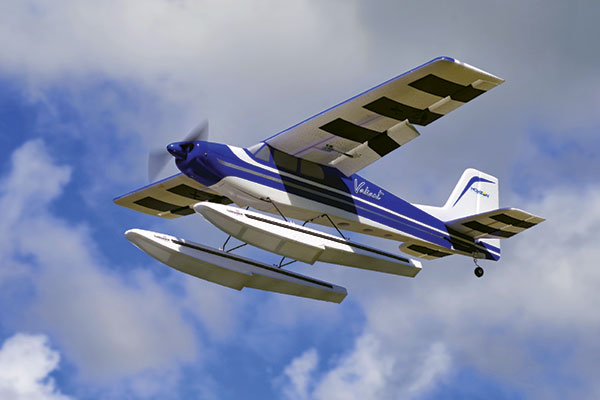
The set of HobbyZone Super Cub floats fit the Valiant perfectly, are nicely priced, and can be mounted in less than 10 minutes.
Switching out the main gear for the optional floats can be done in a few minutes, although the initial float assembly will require extra time. Once assembled, they drop right in place on the underside of the Valiant’s fuselage and are held in place with eight fasteners. Pilots should be aware that there are no provisions for any type of water rudder. Although pilots will probably not notice the omission when performing water-based operations on calm days, the lack of a water rudder will more noticeably manifest itself when it is windy. Pilots well versed in the art of fabrication who are interested in enhancing the Valiant’s water-taxiing abilities can easily fabricate a water rudder. All that is required is a short piece of piano wire, with one end bent to clone the configuration of the included Valiant tail wheel wire. A small square of plastic mounted to the other end of the wire will provide the control authority necessary to capably steer the Valiant on water in windier conditions. The Valiant hardly seems to notice the extra bulk and weight of the floats. Water-based operations with the Valiant are extremely enjoyable! With a moderate headwind and full flaps deployed, the Valiant can be popped up into the air with little more than a few yards of watery runway required. Landings made under these same conditions can be executed with almost zero groundspeed. The Valiant can easily be softly dropped to the water surface within a foot or two of shore for easy retrieval. Should a pilot struggle to steer his or her float-equipped Valiant in stronger wind, simply shutting the power down will allow the wind to push the model to the downwind shore.
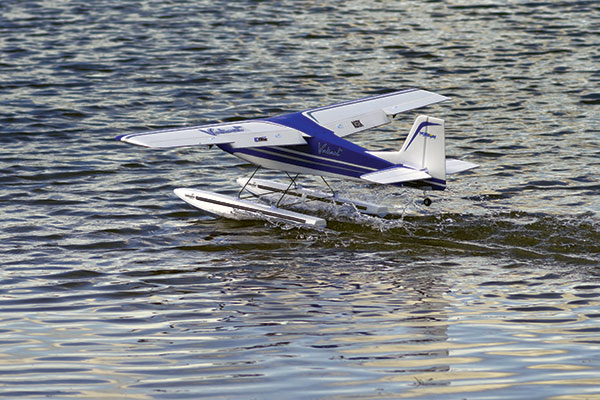










Add new comment